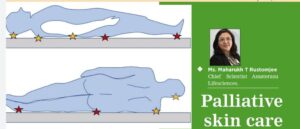Palliative skin care helps people with serious illnesses feel better by preventing or treating symptoms and side effects of disease like Bedsores. The high incidence and prevalence of bedsores confirm the importance of palliative skin care focusing on prevention and management strategies.


Palliative care helps people with serious illnesses feel better by preventing or treating symptoms and side effects of disease and treatment. During palliative care, the primary goal is to ease suffering and help the patient maintain a good quality of life.
Like many other vital organs, the skin, the body’s largest organ, may not function properly and may begin to fail near life’s end. There are many reasons for the skin to lose its function during this time because, the skin has less blood supply as the blood is directed to more vital organs, like the heart and the brain. This makes the skin unable to use important nutrients that would keep it strong and healthy. The skin loses function and can’t protect the body.
Importance of palliative skin care
Even with proper care, the skin may still develop problems, such as wounds or pressure ulcers or bedsores or IAD (Incontinence Associated Dermatitis). Often the changes to the skin can’t be prevented or healed however, there are ways to manage wounds and bedsores to keep a patient comfortable. Bedsores that develop at this stage get worse quickly and often don’t heal.
The high incidence and prevalence of bedsores confirm the importance of palliative skin care focusing on prevention and management strategies. They are driven by patient and family goals integrated with three components of wound management:
1. The management or palliation of the underlying cause of the wound
2. Management of wound-related symptoms
3. Management of the wounds itself
In addition, meticulous skin care for patients of all ages with debilitating long-term conditions is crucial to prevent unnecessary skin breakdown. The key clinical interventions include the application of wound dressings and skin care products.
1. Palliative Care Principles of bedsore, wound care and prevention
The goals of palliative wound care are stabilization of existing wounds, prevention of new wounds (if possible), and symptom management of complications to improve patient comfort, well-being, and quality of life. The general recommendations for four major areas of wound prevention: repositioning, support surfaces, skincare and nutrition.
2. Repositioning
Elderly adults receiving palliative care often have prolonged periods of immobility, which increases the likelihood of bedsore formation. Repositioning for all persons at risk of developing bedsore, the frequency and techniques of which should be individualized to achieve maximal comfort, dignity, and functionality. Any kind of movement while repositioning or helping patient with daily chores may increase friction and shear forces on the skin over the sacrum and bony prominent areas. Application of new age silicone barrier gels in such pressure prone areas may help prevention of friction and shear while such movement.
3. Support Surfaces
Selection of a surface to reduce pressure over bony prominences should take into account the patient’s level of mobility in bed, his or her comfort, and other environmental conditions. Support surfaces include mattresses; overlays, which can be filled with air, water, gel, foam, or a combination of these materials which are designed to provide pressure relief on the body.
4. Nutrition and Hydration
Malnutrition, which is highly common in the palliative care setting, is known to increase the likelihood of bedsore formation and can be a reason why wounds fail to heal or become worse. Nutritional assessment is indicated in palliative care of elderly adults. Additionally, certain medications or symptoms of chronic conditions can affect the absorption of nutrients. As a result, the need to encourage the patient to eat and drink frequently can outweigh other dietary restrictions. One approach to increasing nutritional intake is to offer the patient their favourite food or beverage (within reason).
The importance of water in nutritional status should not be overlooked, as it has been demonstrated that dehydration may increase the risk of bedsore formation and delay healing.
5. Skin care in Palliative Setting
Excess dryness or moisture can make the skin more susceptible to bedsore or wounds. Prevention might involve assessing the state of the skin and applying barrier creams or gel or medicated lotions in case of wounds to the area. At this stage of life, prevention is best form of cure and regular use of barrier creams or gels is recommended to maintain skin integrity. Barrier creams or gels are one of the most effective prevention strategies to manage bedsores. They act as a lubricating film on the skin. Barrier creams help maintain the skin’s physical barrier and stop trans-epidermal water loss. These have protective effects against skin irritants and work by inhibiting direct contact of skin to harmful body fluids such as urine or faecal matter that may cause incontinence associated dermatitis or bedsores.
Patients who experience excess perspiration may need frequent clothing changes or bed linen changes along with application of barrier creams to prevent moisture build-up that can lead to sores.
Conclusion
Caring for the patient with serious illness or patients at end stage of life presents many challenges, not least the maintenance of skin integrity. Occasionally, despite receiving all of the necessary interventions, patients will still develop damage to their skin. These including but not limited to bedsores are now being recognised as inevitable skin changes at life’s end, however, it is still vital that all preventative measures are taken to manage such patients and try to restore quality of their life including palliation of symptoms, provision of optimal care, and using appropriate bedsore prevention techniques.


Ms. Maharukh T Rustomjee
Chief Scientist Amaterasu Lifesciences.











